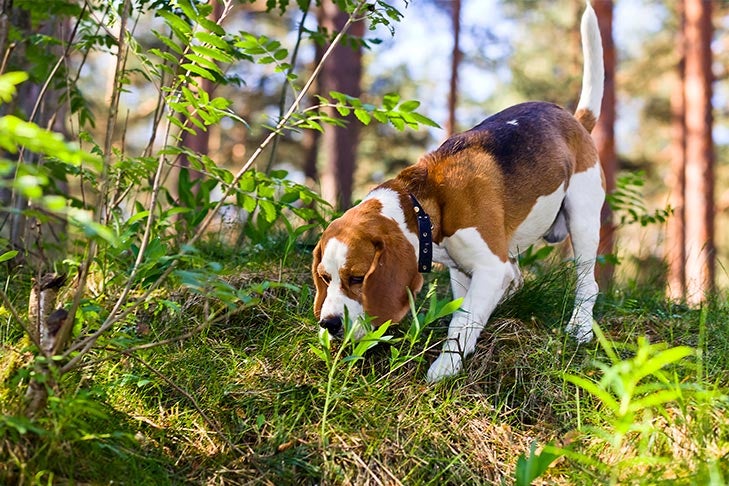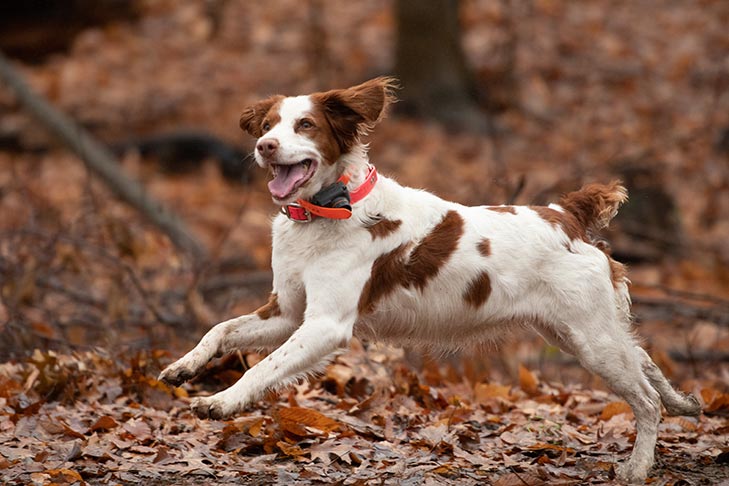
Almost anyone who has come into contact with poison ivy knows the aftermath — an itchy rash and blisters that can last for days. Though it’s rare, dogs can develop a rash or get sick from ingesting poison ivy.
Dr. Hayley Adams, DVM, agrees that while it’s not common, dogs can react to poison ivy. If your vet is concerned that your pet will develop a secondary bacterial skin infection, they may prescribe medications and antibiotics to treat poison ivy. These could be topical, oral, or injected steroid treatments.
What Makes Poison Ivy Toxic?
You may have heard the saying, “Leaves of three, let it be” as a rule of thumb to avoid toxic plants like poison ivy, oak, and sumac. The sap of these plants contains urushiol, an oil that can cause allergic contact hypersensitivity. Between 50% and 75% of people are allergic to urushiol. Allergic reactions to this plant oil have also been observed in animals like dogs, cattle, and horses.
When the chemicals in urushiol react with proteins in the skin, this triggers an immune response, resulting in the skin becoming inflamed. Allergy symptoms can appear within a few hours or days. The rash itself isn’t contagious. But urushiol can remain on surfaces like clothing, garden tools, and even your dog’s fur. Until the affected surface is cleaned or washed, a rash can develop anywhere the oil has touched the skin.

Sometimes, because the oil absorbs into the skin at different rates or the exposure happens more than once, the rash may look like it’s getting bigger. You can’t spread the rash by scratching. But if you (or your dog) scratch or pick at blisters, an infection can result because of the bacteria underneath your fingernails or on your dog’s paws.
In any case, it’s important to limit the transmission of poison ivy. When you’re working outside, make sure to wear gloves, a long-sleeved shirt, and pants tucked into your boots. Clean your gardening tools and gloves between uses. If the oil gets on your skin, wash your hands with soap and water to keep it from spreading.
What’s the Difference Between Poison Ivy, Oak, and Sumac?
Poisonous plants can grow in forests, urban green spaces, and even your own backyard. Knowing how to recognize these plants can help limit exposure.
Poison Ivy
According to the U.S. Food & Drug Administration, poison ivy is found throughout the United States, except for Alaska, Hawaii, and parts of the West Coast. As the saying goes, the leaves grow in clusters of three with a glossy coating and smooth or ridged edges. The vines wrap around trees and poles or spread out on the ground as large shrubs.
Touching any part of the plant from the stems and roots to the berries can cause a rash. Poison ivy has green flower buds that turn white as they open. The leaves are a mixture of red and green in spring, green in summer, and orange, yellow, or red in the fall.
Poison Oak
Similar in appearance to poison ivy, poison oak is found in the eastern and southern U.S. states. The leaves are green and red or a combination of both. Often growing in threes, the leaves have rounded tips and a fuzzy texture. Poison oak often grows as a shrub and has white-yellow berries.
Poison Sumac
This plant is found in the marshlands of the Northeast, Midwest, and Southeast. The leaves have a smooth edge and grow in clusters of seven or more. Sumac grows as a tall shrub or small tree and produces yellow flowers and light green fruits. The leaves are green in summer and turn yellow, orange, or red in the fall.
What Are Symptoms of Poison Ivy in Dogs?

Exposure to poison ivy, oak, or sumac can occur when dogs walk through a wooded area and brush up against these plants. Their skin tends to be less sensitive to urushiol compared to people. A dog’s fur adds a layer of protection because it makes it harder for the oil to reach the skin, but short-haired or thin coated dogs may be more likely to be affected. “Although there may be breed-specific predilections for an allergic response to poison ivy, it is more likely related to the dog’s fur coverage,” says Dr. Adams. If your dog has more exposed skin, they may be more likely to come into contact with poison ivy. Shorter dogs “may brush up against the plants, especially on their bellies or groin, which have little to no fur,” she adds. Also, spending time hiking or in heavily wooded areas may increase your dog’s likelihood of exposure.
While allergic -reactions to these plants are less common in dogs, when they do occur, you should keep an eye out for the following symptoms:
- Red, swollen skin
- Itching
- Vomiting
- Diarrhea
- Blisters
Dr. Sarah Nold, DVM, cautions that if you suspect your dog is having a reaction to these plants, take them to the vet for an exam. “It is more likely that they are suffering from another condition, such as a contact allergy to another plant, skin mites, or allergies, and will benefit from medication not available over the counter,” she explains. If your dog experiences a change in behavior or a worsening skin condition, contact your veterinarian.
Aside from touching the oil, there’s also the possibility of your dog ingesting poison ivy, oak, or sumac. For most dogs, this can lead to an upset stomach. If you think your dog has consumed poison ivy, monitor them for symptoms like redness, swelling, vomiting, or diarrhea. In rare instances, dogs may go into anaphylactic shock. Difficulty breathing could be a sign of a severe allergic reaction, in which case your dog will require immediate veterinary attention.
Protecting Your Dog From Poison Ivy

If you have a dog with sensitive skin, you should keep them away from these plants, just in case. “After being in an area with poison ivy or oak, you should wash your dog,” says Dr. Nold.
Follow these bathing and cleaning tips to avoid contracting poison ivy:
- Wear waterproof gloves (rubber or nitrile) and long sleeves when bathing your dog.
- Apply bentoquatam lotion to your skin. This creates a barrier between urushiol and the skin.
- Rinse your dog’s coat thoroughly with cool or lukewarm water.
- Use dog shampoo to remove oil from their coat. Products containing oatmeal can help soothe the skin.
- Work the shampoo into the coat, creating a lather and avoiding their eyes, ears, rectal, or genital area.
- Make sure to rinse all the soap off and dry your dog with a towel.
- Wash your dog’s bedding, collar, leash, and towels, as well as your clothes, with a grease-cutting detergent and hot water.
- Clean hard surfaces with rubbing alcohol. Be sure to rinse and dry the area before your dog is allowed near them.
- Use a carpet cleaner on rugs and fabric that can’t be machine washed.
Remember, even if your dog doesn’t develop a rash from poison ivy or oak, they can still transmit the oil to you or anyone else who comes in contact with them. Because urushiol can stick around on surfaces for months and even years, it’s a good idea to remove these plants from your yard or around your home. Burning isn’t a safe method of disposal because this process releases the oil, which is toxic if inhaled by you or your dog.

You can either hire someone or follow these steps to safely dispose of poison ivy:
- Wear gloves and protective clothing.
- Use shears to clip the plants.
- Avoid ripping the stems and roots, a process that releases the oil.
- Use a shovel to dig out the roots and spray the area with a pet-safe weed killer.
- Dispose of the plants in a garbage bag.
- Discard your gloves and clothing or wash them in hot water.
It’s also a good idea to keep your dog on a leash if you’re planning to venture into a heavily wooded area. Have a towel on hand to wipe their paws and gloves to protect your skin. Doing your research and knowing how to spot these plants can help you avoid a nasty run-in.

